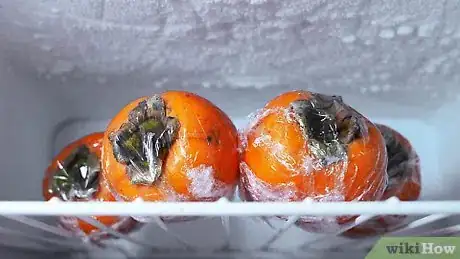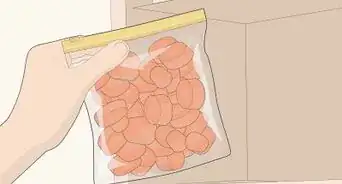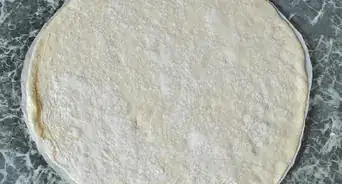This article was co-authored by wikiHow staff writer, Hannah Madden. Hannah Madden is a writer, editor, and artist currently living in Portland, Oregon. In 2018, she graduated from Portland State University with a B.S. in Environmental Studies. Hannah enjoys writing articles about conservation, sustainability, and eco-friendly products. When she isn’t writing, you can find Hannah working on hand embroidery projects and listening to music.
There are 7 references cited in this article, which can be found at the bottom of the page.
The wikiHow Culinary Team also followed the article's instructions and verified that they work.
This article has been viewed 17,802 times.
Learn more...
Persimmons are a sweet, delicious treat that you can eat on their own or in baked goods. If you have a lot of persimmons and you don’t want them to go to waste, you can store them in the freezer for a few months until you’re ready. Either freeze them whole to eat raw or turn them into a pureé to cook with, and enjoy your persimmons for months to come.
Steps
Whole Persimmons
-
1Store the fruit at room temperature for 1 to 2 weeks if it isn’t ripe. This will help the ripening process. You can store them next to apples or pineapples to speed them up, but they’ll stay tough and firm for a couple of weeks.[1]
- You can also keep unripe persimmons in your fridge, but they won’t ripen as quickly.
- If your persimmons are already ripe, don’t worry about keeping them at room temperature. You can go straight to freezing them.
-
2Place the persimmons on a tray and freeze them for 1 to 2 hours. Spread your persimmons out on a baking tray in a single layer. Put the tray in the freezer for a few hours to make them firm and harden up.
- You can also put your persimmons in a bag, but they might take a little longer to get firm.
Advertisement -
3Wrap each persimmon individually with plastic wrap. You can also use a plastic bag. Wrap each persimmon in one layer of plastic wrap to keep them from getting freezer burn. Freezing each one individually will make them easier to eat, too.[2]
- Wrapping the fruit after it’s already frozen will make it less likely to bruise.
-
4Place the persimmons back into the freezer. They shouldn’t take long to freeze —an hour or two and they’ll be fully frozen! Make sure they aren’t squished behind anything or underneath anything in your freezer.[3]
- If you’re worried about freezer burn, place your persimmons into an airtight container before you freeze them.
- You can freeze whole persimmons indefinitely, but they’ll start to lose their taste and texture after about 3 months.
-
5Let the persimmons thaw at room temp for 20 minutes before you eat them. When you want a deliciously cold snack, take a persimmon out of the freezer and let it sit at room temperature. Cut the top off and eat the insides with a spoon for a yummy treat.[4]
- The persimmons will stay sweet even after they’re frozen.
Persimmon Pureé
-
1Wash your fruit in the sink and dry them off. When your persimmons feel squishy to the touch, they’re ripe! Wash them off using water from the sink and pat them dry with a towel.[5]
- Once your persimmons are ripe, you can feel free to snack on a couple before you freeze them. They’ll taste sweet, not astringent, so they’ll be delicious!
-
2Cut each persimmon into quarters. This will make them easier to pureé. You can skin the persimmons beforehand if you want to, or you can leave them on for some added fiber.[6]
- Persimmons may be easier to turn into a pureé if you skin them first.
-
3Press each piece of persimmon through a sieve. Grab a bowl and balance your sieve over it. Hold the piece of persimmon up against the sieve and push it through with the back of the spoon. Go slowly so you break down each piece into pulpy goodness.[7]
- If you go too fast, you run the risk of not breaking down each piece all the way. This can lead to some chunky pureé.
- If you don’t want to deal with a sieve, blitz your persimmon pieces in a food processor or a blender.
-
4Add 1/8 tsp (375 mg) of ascorbic acid to every 1 US qt (0.95 L) of pureé. Measure your pureé to see how much you have. Add in some ascorbic acid so the persimmons keep their bright color in the freezer.[8]
- If you don’t have ascorbic acid, use lemon juice instead.
- Your pureé will taste fine without this, but it may turn brown.
-
5Pour the pureé into canning jars. This will keep your mixture fresh in the freezer so you can enjoy it long-term. Use any size jars that you’d like, as long as they all have lids.[9]
- Make sure you leave enough headspace at the top of the jar. If you’re storing 1 US pt (470 mL), leave 0.5 in (1.3 cm) of space; if you’re storing 1 US qt (0.95 L), leave 1 in (2.5 cm) of space.[10]
- Since you’re freezing your jars, you don’t have to sanitize them before storing your mixture.
-
6Seal the cans and place them in the freezer. You can keep frozen pureé around for about 3 months before it starts to lose its flavor. When you want to eat it, simply take a jar out of the freezer and let it thaw for about 10 minutes.[11]
- You can use pureé in baked goods and jams.
Things You’ll Need
Whole Persimmons
- Baking tray
- Plastic wrap
Persimmon Pureé
- Knife
- Sieve
- Spoon
- Canning jars
References
- ↑ https://www.centraltexasgardener.org/resource/preparing-persimmons-for-freezing-or-for-cooking/
- ↑ https://www.cooks.com/recipe/577169ej/freezing-whole-soft-persimmons.html
- ↑ https://farmtotablela.com/fuyu-persimmons-and-what-to-do-with-them/
- ↑ https://farmtotablela.com/fuyu-persimmons-and-what-to-do-with-them/
- ↑ https://www.cooks.com/recipe/577169ej/freezing-whole-soft-persimmons.html
- ↑ https://nchfp.uga.edu/how/freeze/persimmon.html
- ↑ https://ucanr.edu/blogs/blogcore/postdetail.cfm?postnum=43855
- ↑ https://nchfp.uga.edu/how/freeze/persimmon.html
- ↑ https://nchfp.uga.edu/how/freeze/persimmon.html























































